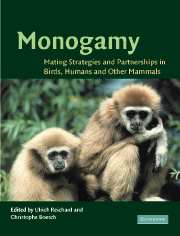Book contents
- Frontmatter
- Contents
- List of contributors
- Acknowledgements
- Introduction
- PART I Evolution of social monogamy
- PART II Reproductive strategies of socially monogamous males and females
- CHAPTER 6 Social functions of copulation in the socially monogamous razorbill (Alca torda)
- CHAPTER 7 Social and reproductive monogamy in rodents: the case of the Malagasy giant jumping rat (Hypogeomys antimena)
- CHAPTER 8 Social polyandry and promiscuous mating in a primate-like carnivore: the kinkajou (Potos flavus)
- CHAPTER 9 Monogamy correlates, socioecological factors, and mating systems in beavers
- CHAPTER 10 Social monogamy and social polygyny in a solitary ungulate, the Japanese serow (Capricornis crispus)
- PART III Reproductive strategies of human and non-human primates
- Index
CHAPTER 9 - Monogamy correlates, socioecological factors, and mating systems in beavers
Published online by Cambridge University Press: 05 July 2014
- Frontmatter
- Contents
- List of contributors
- Acknowledgements
- Introduction
- PART I Evolution of social monogamy
- PART II Reproductive strategies of socially monogamous males and females
- CHAPTER 6 Social functions of copulation in the socially monogamous razorbill (Alca torda)
- CHAPTER 7 Social and reproductive monogamy in rodents: the case of the Malagasy giant jumping rat (Hypogeomys antimena)
- CHAPTER 8 Social polyandry and promiscuous mating in a primate-like carnivore: the kinkajou (Potos flavus)
- CHAPTER 9 Monogamy correlates, socioecological factors, and mating systems in beavers
- CHAPTER 10 Social monogamy and social polygyny in a solitary ungulate, the Japanese serow (Capricornis crispus)
- PART III Reproductive strategies of human and non-human primates
- Index
Summary
INTRODUCTION
Mating systems are among the central topics in the study of animal social organization. Monogamy is loosely defined and used to refer to the situation in which amating pair stays together exclusively for at least one breeding season (e.g., Fuentes, 1999). Obviously, this definition applies only to social, not genetic, monogamy. In the following discussion, unless otherwise indicated, I use the term monogamy to refer to social monogamy.
Kleiman (1977) was the first to summarize mating systems in mammals and found that fewer than 3% of mammalian species were socially monogamous (also see Rutberg, 1983; Kinzey, 1987). This was in sharp contrast to birds, where about 90% of the species were traditionally believed to be socially monogamous (Lack, 1968). This general impression was prevalent for decades until a recent flurry of data revealed that many of these socially monogamous birds and mammals routinely engage in extra-pair copulations (EPCs) (see Birkhead & Møller, 1995; Fuentes, 2002). Several chapters in this volume provide some fresh data about EPCs in mammals, which are less studied than birds in this respect.
In mammals, parental investment is extremely skewed towards females owing to the time- and energy consuming aspects of mammalian female gestation and lactation. As a result, male mammals are selected for reproducing more polygynously than males in other groups of animals. Males provide parental care in fewer than 10% of mammalian species (Woodroffe & Vincent, 1994). However, even male parental care does not necessarily lead to social monogamy, and based on a few socially monogamous species that have been genetically screened (see Ribble, chapter 5; Fietz, chapter 14), strict genetic monogamy appears to be much rarer in mammals.
- Type
- Chapter
- Information
- MonogamyMating Strategies and Partnerships in Birds, Humans and Other Mammals, pp. 138 - 146Publisher: Cambridge University PressPrint publication year: 2003
- 15
- Cited by



